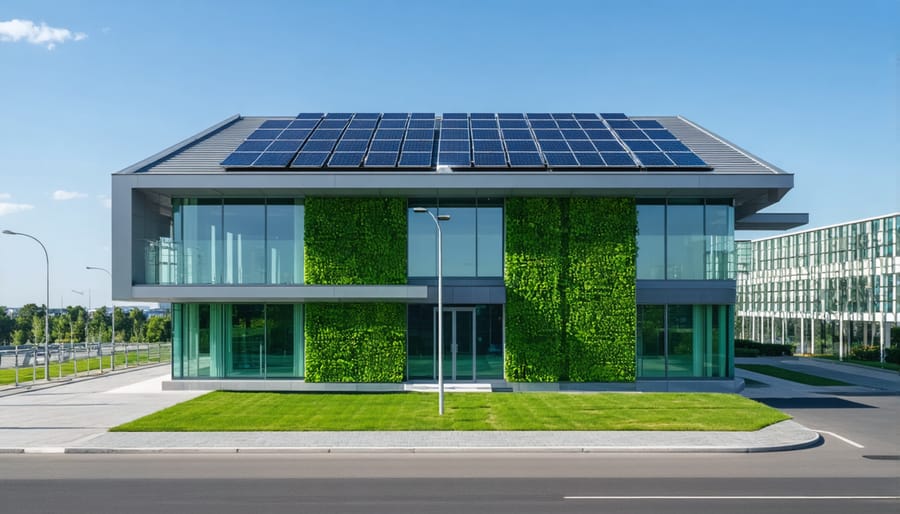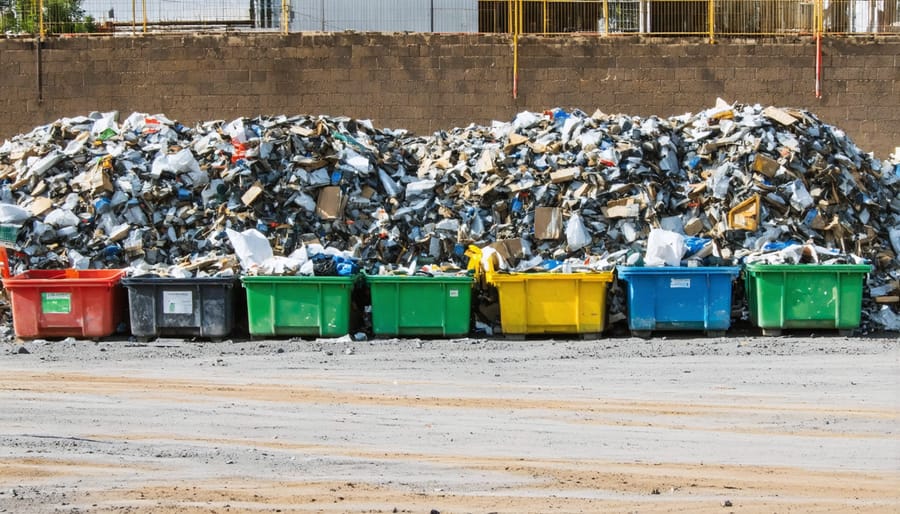Achieving zero carbon footprint in construction demands a fundamental transformation of traditional building practices. As global climate targets become increasingly stringent, implementing sustainable construction management practices has evolved from an optional consideration to an imperative industry standard. Recent data from the World Green Building Council indicates that buildings account for 39% of global carbon emissions, with operational emissions representing 28% and embodied carbon contributing the remaining 11%.
The construction industry stands at a critical juncture where pioneering technologies, innovative materials, and advanced methodologies converge to make carbon neutrality achievable. From the integration of carbon-negative materials to the implementation of artificial intelligence-driven energy management systems, the path to zero carbon footprint requires a comprehensive, systematic approach that encompasses the entire building lifecycle.
For construction professionals and industry stakeholders, understanding and implementing zero carbon strategies isn’t merely about environmental stewardship—it’s about future-proofing projects, ensuring regulatory compliance, and maintaining competitive advantage in an increasingly carbon-conscious market. This transformation demands precise planning, substantial investment in sustainable technologies, and unwavering commitment to environmental excellence throughout the construction process.
The Evolution of Carbon-Neutral Construction

Regulatory Framework and Industry Standards
The regulatory landscape for zero-carbon buildings continues to evolve rapidly, with governments worldwide implementing increasingly stringent requirements. The International Building Code (IBC) and Leadership in Energy and Environmental Design (LEED) certification systems have established foundational construction sustainability metrics that serve as benchmarks for the industry.
Key regulations include the European Union’s Energy Performance of Buildings Directive (EPBD), which mandates all new buildings be nearly zero-energy by 2030. In North America, California leads with Title 24 Building Energy Efficiency Standards, requiring all new residential construction to be zero-net-energy by 2025. The ASHRAE 189.1 Standard provides comprehensive guidelines for high-performance green buildings.
Certification programs like BREEAM, LEED Zero Carbon, and the International Living Future Institute’s Zero Carbon Certification offer robust frameworks for verification. These programs typically require documented evidence of renewable energy integration, carbon offset strategies, and ongoing performance monitoring.
Project teams must navigate multiple compliance pathways, including:
– Energy performance documentation
– Carbon footprint calculations
– Renewable energy certificates
– Third-party verification
– Annual reporting requirements
Industry standards are increasingly focusing on embodied carbon alongside operational emissions, with emerging requirements for Environmental Product Declarations (EPDs) and whole-building lifecycle assessments becoming mandatory in many jurisdictions.
Market Drivers and Economic Benefits
The drive toward zero-carbon construction is increasingly influenced by both regulatory pressures and market demands. Recent analysis shows that buildings implementing zero-carbon strategies demonstrate a 15-20% premium in property value compared to conventional structures. This economic advantage stems from reduced operational costs, enhanced tenant attraction, and improved long-term asset resilience.
Government policies, particularly in developed nations, are creating powerful incentives through carbon taxation and emissions trading schemes. The European Union’s commitment to achieving carbon neutrality by 2050 has sparked substantial investment in zero-carbon technologies, while similar initiatives in North America and Asia are reshaping construction requirements.
Market research indicates that tenants are willing to pay 8-12% higher rents for zero-carbon buildings, driven by corporate sustainability commitments and employee preferences. Additionally, zero-carbon properties typically realize 25-30% reduction in energy costs, significantly improving their operational economics over building lifecycles.
Insurance companies are increasingly factoring carbon footprint into risk assessments, offering preferential rates for zero-carbon buildings. Financial institutions are also developing green financing products, providing favorable terms for zero-carbon projects. This combination of reduced operational costs, higher asset values, and improved financing options creates a compelling business case for zero-carbon construction, particularly in commercial and institutional sectors.
The emergence of carbon offset markets provides additional revenue streams, allowing building owners to monetize their carbon reductions through verified credit trading systems.
Innovative Materials and Design Strategies
Low-Carbon Building Materials
The shift towards innovative building materials has become crucial in achieving zero carbon footprint goals in construction. Mass timber, particularly cross-laminated timber (CLT), has emerged as a leading alternative to traditional steel and concrete, offering significant carbon sequestration benefits while maintaining structural integrity. Recent studies indicate that CLT buildings can reduce embodied carbon by up to 40% compared to conventional construction methods.
Low-carbon concrete alternatives, incorporating supplementary cementitious materials like fly ash and ground granulated blast furnace slag, are revolutionizing foundation work. These materials reduce cement content while maintaining or even improving structural performance, resulting in up to 70% lower carbon emissions during production.
Recycled steel and aluminum products are gaining traction, with manufacturing processes increasingly powered by renewable energy. These materials not only reduce virgin resource extraction but also decrease energy consumption in production by up to 95% compared to traditional methods.
Bio-based materials, including hemp-lime composites and mycelium insulation, are showing promising results in both thermal performance and carbon reduction. These materials actively sequester carbon during growth and require minimal processing energy, creating a negative carbon footprint in some applications.
Advanced glass technologies, featuring electrochromic and photovoltaic properties, are dual-purpose solutions that reduce both embodied carbon and operational energy requirements. When combined with optimized building envelope design, these materials can decrease building energy consumption by up to 30%.
Implementation success requires careful consideration of local availability, supply chain logistics, and lifecycle assessment to ensure genuine carbon reductions throughout the building’s lifespan.

Passive Design Integration
Passive design integration represents a cornerstone of achieving zero carbon footprint in modern construction projects. By leveraging natural environmental conditions and architectural design principles, buildings can significantly reduce their operational energy requirements without relying on mechanical systems. These energy-efficient design strategies focus on maximizing solar gain, natural ventilation, and thermal mass properties.
Key passive design elements include strategic building orientation, which optimizes solar exposure during winter months while minimizing unwanted heat gain during summer. High-performance building envelopes incorporating advanced insulation materials and air-sealing techniques create an effective thermal barrier. Careful window placement and glazing specifications enhance daylighting while managing solar heat gain through seasonal variations.
Natural ventilation systems, such as stack effect ventilation and cross-ventilation, reduce reliance on mechanical cooling. These systems can be enhanced through computational fluid dynamics modeling to optimize airflow patterns. Thermal mass elements, such as exposed concrete floors or phase-change materials, help regulate indoor temperatures by absorbing excess heat during the day and releasing it during cooler periods.
Green roofs and living walls serve dual purposes: providing additional insulation while supporting biodiversity and reducing urban heat island effects. Light-colored or reflective roofing materials further minimize heat absorption. Incorporating these passive design elements during the early planning stages is crucial, as retrofitting them later can be both costly and less effective.
The success of passive design integration relies heavily on climate-specific strategies and detailed site analysis. This approach requires close collaboration between architects, engineers, and energy consultants to ensure optimal performance throughout the building’s lifecycle.

Construction Process Optimization
Site Management and Waste Reduction
Effective site management and waste reduction strategies are crucial components in achieving zero carbon footprint in construction projects. By implementing a comprehensive Construction Waste Management Plan (CWMP), projects can significantly reduce landfill waste and associated emissions. Key practices include careful material quantification during the planning phase to prevent over-ordering, and the establishment of on-site sorting stations for recyclable materials such as concrete, metal, wood, and plastics.
Digital tracking systems help monitor waste generation and disposal patterns, enabling real-time adjustments to procurement and handling processes. Modern construction sites are increasingly adopting prefabrication techniques, which can reduce waste by up to 90% compared to traditional methods. Additionally, implementing a closed-loop material management system ensures that surplus materials from one project can be efficiently redistributed to other sites.
Site emissions can be minimized through strategic equipment placement, optimized delivery schedules, and the use of electric or hybrid construction machinery. Dust suppression systems and proper material storage further contribute to reducing environmental impact. Regular training sessions for site personnel ensure consistent adherence to waste reduction protocols and proper material handling procedures.

Case Study: The Future is Here
The Edge, a 40,000-square-meter office building in Amsterdam, stands as a testament to what’s achievable in zero-carbon construction. Completed in 2015 by OVG Real Estate, this groundbreaking project achieved the highest BREEAM sustainability score ever recorded: 98.36%.
The building’s design incorporates an array of innovative technologies and strategies that work in harmony to maintain a zero-carbon footprint. Solar panels, both on the roof and southern-facing walls, generate more electricity than the building consumes. Rainwater harvesting systems collect and reuse water for toilets and irrigation, while an aquifer thermal energy storage system provides efficient heating and cooling.
What sets The Edge apart is its smart building management system. Over 28,000 sensors monitor occupancy, movement, lighting levels, humidity, and temperature. This data-driven approach enables real-time adjustments to energy usage, ensuring optimal efficiency without compromising occupant comfort.
The project team faced several challenges during implementation. The initial cost premium for sustainable technologies was 20% higher than conventional construction. However, the return on investment analysis showed complete cost recovery within eight years through reduced operational expenses and energy savings.
Key achievements include:
– 70% reduction in energy consumption compared to typical office buildings
– Net-positive energy production
– 98% of construction materials were recycled or sustainably sourced
– Zero waste to landfill during construction
– Annual carbon savings of 42,000 tons CO2 equivalent
The success of The Edge has influenced numerous construction projects worldwide. The building’s innovative approaches to energy management, material selection, and waste reduction have become benchmarks for sustainable construction. Perhaps most significantly, it demonstrates that achieving zero carbon footprint in large-scale commercial construction is not just theoretically possible but commercially viable.
The project’s success has led to new standards in sustainable building certifications and inspired updates to building codes in several European countries, proving that today’s showcase projects can become tomorrow’s industry standards.
The journey toward zero-carbon construction represents both a significant challenge and an unprecedented opportunity for the building industry. As we’ve explored throughout this article, achieving a carbon-neutral footprint requires a comprehensive approach that combines innovative materials, advanced technologies, and strategic planning methodologies.
The construction sector stands at a crucial turning point, with increasing pressure from regulations, market demands, and environmental imperatives driving the shift toward sustainable practices. Success stories from pioneering projects demonstrate that zero-carbon construction is not only feasible but can also deliver substantial long-term benefits, including reduced operational costs and enhanced building performance.
Looking ahead, several key trends will shape the future of zero-carbon construction. The continued advancement of sustainable materials, improved energy storage solutions, and the integration of artificial intelligence in building management systems will further streamline the path to carbon neutrality. Additionally, the growing adoption of circular economy principles and the development of more sophisticated carbon accounting tools will enable more precise tracking and reduction of embodied carbon.
For construction professionals, staying ahead of these developments while maintaining practical feasibility will be crucial. The industry must balance ambitious environmental goals with economic viability, ensuring that zero-carbon solutions become the standard rather than the exception. Through continued innovation, collaboration, and commitment to sustainable practices, the construction sector can play a pivotal role in addressing climate change while creating buildings that serve both people and the planet.

